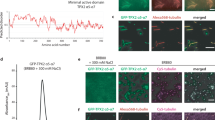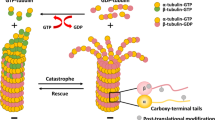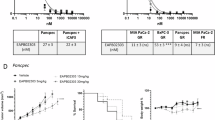Abstract
We have studied the state of microtubule associated protein 2 (MAP2) in the pancreatic ductal adenocarcinomas P03 and P02 (sensitive and refractory to docetaxel respectively) since they express the corresponding mRNA and MAP2-related peptides. Immunohistochemical localization showed that in tumour P03 the MAP2-related peptides are highly expressed and confined to the epithelial malignant cells while in P02 the intensity of the immunostaining is lower. However, anti α-tubulin staining followed a similar pattern suggesting that the net amount of macromolecular structures in the sensitive tumour is higher than in the refractory one. This may explain its higher sensitivity to docetaxel, because tubulin assembled into microtubules is the target of the drug. We found that protein extracts from both tumours differed in their proteolytic activity on rat brain MAP2. Since the proteolysis pattern obtained was similar to the one produced by Cathepsin D, we studied the effect of MAP2 proteolysed by this enzyme on microtubule formation in vitro. Proteolysis was found to increase the tendency of tubulin to assemble into macromolecular structures (microtubules and aggregates) in the presence of docetaxel. This suggests that in vitro proteolysis of MAP2 might increase microtubule alterations and potentiate the antitumour effect of docetaxel. © 2000 Cancer Research Campaign
Similar content being viewed by others

Article PDF
Change history
16 November 2011
This paper was modified 12 months after initial publication to switch to Creative Commons licence terms, as noted at publication
References
Bissery MC, Guenard D, Gueritte-Voegelein F and Lavelle F (1991) Experimental antitumor activity of Taxotere (RP56976, NSC 628503), a taxol analogue. Cancer Res 51: 4845–4852
Bissery MC, Nohynek G, Sanderink G-J and Lavelle F (1995) Docetaxel (Taxotere): a review of preclinical and clinical experience. Part I: preclinical experience. Anti-cancer Drugs 6: 339–355
Combeau C, Commerçon A, Mioskowski C, Rousseau B, Aubert F and Goldner M (1994) Predominant labeling of β over α tubulin from porcine brain by a photoactivable taxoid derivative. Biochemistry 33: 6676–6683
Fellous A, Francon J, Lennon AM and Nunez J (1997) Microtubule assembly in vitro. Purification of assembly promoter factors. Eur J Biochem 78: 167–174
Fellous A, Prasad V, Ohayon R, Jordan MA and Luduena RF (1994) Removal of the projection domain of microtubule-associated protein 2 alters its interaction with tubulin. J Prot Chem 13: 381–391
Fromes Y, Gounon P, Veitia R, Bissery MC and Fellous A (1996) Influence of Microtubule-associated proteins on the differential effects of paclitaxel and docetaxel. J Prot Chem 15: 377–388
Haber M, Burkhart CA, Lee Regl D, Madafiglio J, Norris MD and Horvitz SB (1995) Altered expression of Mβ2, the class ii β-tubulin isotype, in a murine J774.2 cell line with a high level of taxol resistance. J Biol Chem 270: 31269–31275
Jaffrézou J-P, Dumontet C, Derry WB, Duran G, Chen G, Tsuchiya E, Wilson L, Jordan MA and Sikic BI (1995) Novel mechanism of resistance to Paclitaxel (taxol) in human K562 leukemia cells by combined selection with PSC 833. Oncol Res 7: 517–527
Kalil J, Fellous A and Fellous M (1988) Applications de I'immunilogie aux cultures in vitro. In Culture de cellules animales: Methodologies et applications, Adolphe M, Barlovats-Meimon G (eds). pp. 101–130, Les Editions INSERM: Paris
Lavelle F and Fizames C (1989) Experimental properties of RP56976, a taxol derivative. Proc. AACR 30: 566
Lavelle F, Bissery MC, Combeau C, Riou JF, Vrignaud P and Andre S (1995) Preclinical evaluation of Docetaxel (Taxotere). Seminars in Oncology 22(2), Suppl. 4: 3–16
Parness J and Horwits SB (1981) Taxol binds to polymerized tubulin in vitro. J Cell Biol 91: 479–487
Van Oosterom AT and Schrijvers D (1995) Docetaxel (Taxotere): a review of preclinical and clinical experience. Part I: preclinical experience. Anti-cancer Drugs 6: 356–368
Veitia R, Bissery MC, Martinez C and Fellous A (1998) Tau expression in murine adenocarcinomas correlates with docetaxel sensitivity in tumor-bearing mouse. British J Cancer 78: 871–877
Weingarten MD, Lockwood AH, Hwo SY and Kirschner MW (1975) A protein factor essential for microtubule assembly. Proc Natl Acad Sci USA 72: 1848–1852
Author information
Authors and Affiliations
Rights and permissions
From twelve months after its original publication, this work is licensed under the Creative Commons Attribution-NonCommercial-Share Alike 3.0 Unported License. To view a copy of this license, visit http://creativecommons.org/licenses/by-nc-sa/3.0/
About this article
Cite this article
Veitia, R., David, S., Barbier, P. et al. Proteolysis of microtubule associated protein 2 and sensitivity of pancreatic tumours to docetaxel. Br J Cancer 83, 544–549 (2000). https://doi.org/10.1054/bjoc.2000.1294
Received:
Revised:
Accepted:
Published:
Issue date:
DOI: https://doi.org/10.1054/bjoc.2000.1294
This article is cited by
-
Expression of the microtubule-associated protein 2 (MAP2) as a potential independent prognostic marker in prostate cancer
Journal of Cancer Research and Clinical Oncology (2024)
-
End-binding protein 1 stimulates paclitaxel sensitivity in breast cancer by promoting its actions toward microtubule assembly and stability
Protein & Cell (2014)
-
MAP-2 Expression in the Human Adenohypophysis and in Pituitary Adenomas. An Immunohistochemical Study
Pituitary (2005)


